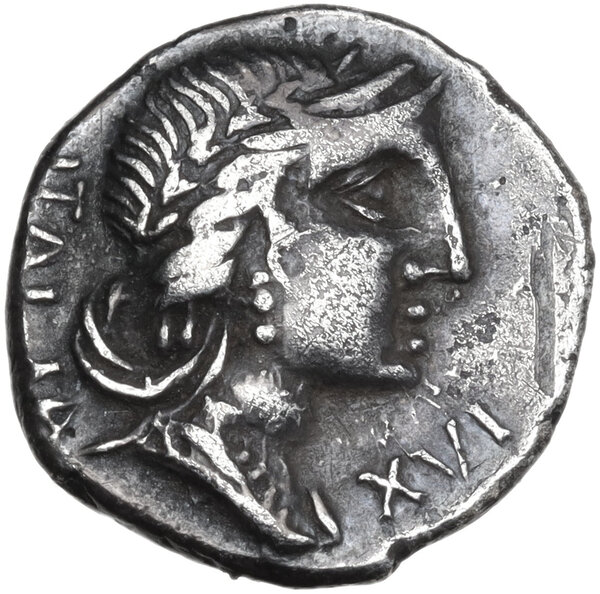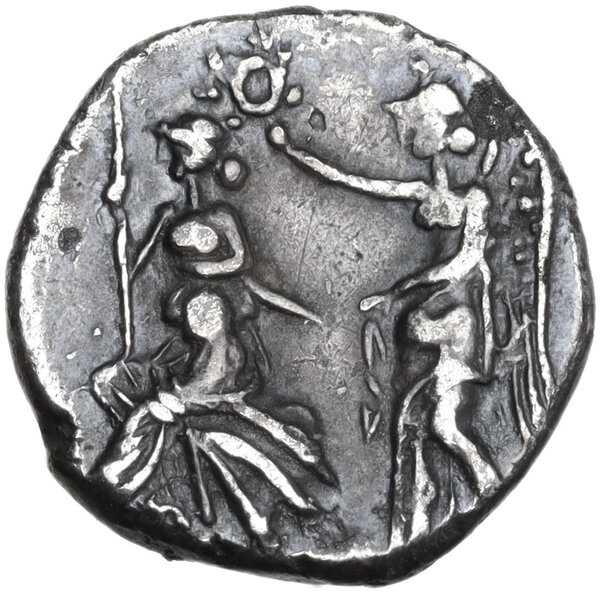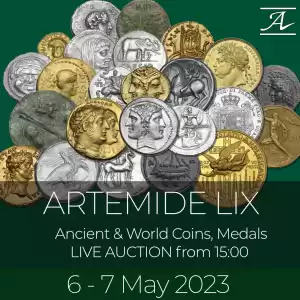

The Bellum Sociale, 90-88 BC. AR Denarius, Corfinium mint, c. 89 BC. Obv. Laureate and draped bust of Italia right; ITALIA downwards behind, XVI upwards before. Rev. Victory standing left, crowning Italia seated to left on three stacked shields, holding spear and sword; [Latin letter in exergue]. Campana 115; HN Italy 414. 3.69 g. 17.00 mm. RR. Very rare and choice for issue. Lovely bright old cabinet tone. VF.
However, the formation of an Italian league and the construction of a new political centre at Corfinium, dubbed 'Italica', with its own senate, suggests a genuine and long-standing desire for independence, despite the fact that it was conceived with an almost identical political structure to Rome. Numismatic evidence supports this idea: while minting a substantial new coinage was a firm assertion of authority, it was still minted along Roman models, denominations and types, often, as in this case, simply replacing a personification of Rome with that of Italy, and the minting authority 'ROMA' with a Latin inscription 'ITALIA' proclaiming the new state. The reverse type of Victory crowning Italia emphatically demonstrates opposition to Rome, yet however revolutionary, these coins were compatible with and intended for use within the Roman system.
Pobjoy has remarked upon the use of different languages on rebel coinage, interpreting the use of Latin script as another demonstration of the reliance on Roman models due to the fact that, ironically, Latin was the principle language of the Italian rebel states. It was often combined with Oscan (such as on lot 734), the language of the states who had historically formed the core of resistance against Rome since the fourth century BC, the use of which is 'best seen as a direct assertion of non-Roman identity', since it held resonant associations of independence after its appearance on the coinage of the rebel Italian states who joined Hannibal in the Punic wars (Pobjoy 2000, p.200).
Ex NAC Autumn Sale 95, 1995, 321.
The question of the aims and motives of the Italian states who rebelled against Roman rule in the Social War of 91-87 BC has been a subject of much debate in historical discourse, which coalesced into two polarised arguments, which assert that either they were motivated by a desire for citizenship and inclusion within the Roman state, or, alternatively, it was a desire for independence from, and ultimate destruction of, that state. Scholars have often viewed the ultimate enfranchisement of the rebel Italian states as indication that the rebels sought only Roman citizenship, an interpretation reinforced by the Romano-centric commentary of ancient historians such as Diodorus Siculus, Velleius Paterculus, Appian and Cicero.However, the formation of an Italian league and the construction of a new political centre at Corfinium, dubbed 'Italica', with its own senate, suggests a genuine and long-standing desire for independence, despite the fact that it was conceived with an almost identical political structure to Rome. Numismatic evidence supports this idea: while minting a substantial new coinage was a firm assertion of authority, it was still minted along Roman models, denominations and types, often, as in this case, simply replacing a personification of Rome with that of Italy, and the minting authority 'ROMA' with a Latin inscription 'ITALIA' proclaiming the new state. The reverse type of Victory crowning Italia emphatically demonstrates opposition to Rome, yet however revolutionary, these coins were compatible with and intended for use within the Roman system.
Pobjoy has remarked upon the use of different languages on rebel coinage, interpreting the use of Latin script as another demonstration of the reliance on Roman models due to the fact that, ironically, Latin was the principle language of the Italian rebel states. It was often combined with Oscan (such as on lot 734), the language of the states who had historically formed the core of resistance against Rome since the fourth century BC, the use of which is 'best seen as a direct assertion of non-Roman identity', since it held resonant associations of independence after its appearance on the coinage of the rebel Italian states who joined Hannibal in the Punic wars (Pobjoy 2000, p.200).


